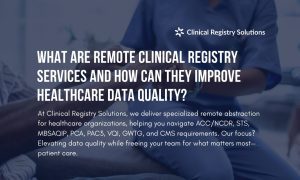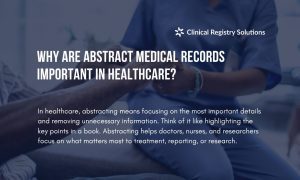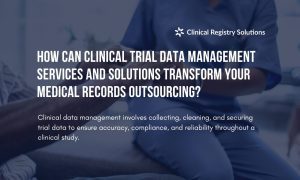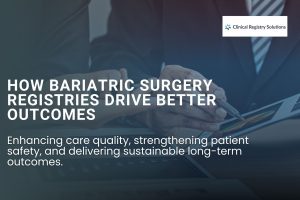The healthcare field is an ever-evolving one. Healthcare providers such as hospitals and clinics are constantly adapting to policies and regulations, competing demands from patients, and rapidly advancing technologies. Perhaps the most challenging of all is the management of the enormous volume of medical data. Clinical data abstraction assists in this regard, as it helps simplify the information and make it both accessible and comprehensible.
This blog will discuss the relevance of clinical data abstraction in transforming data, its processes, and its implications for patients, physicians, and the entire healthcare ecosystem.
What Is Clinical Data Abstraction?
Consider a scenario where you visit a physician. Your consultation will be associated with a distinct medical chart. Gradually, this chart will be supplemented by more test results, documented allergies, new diagnoses, and treatments. Now, imagine a single hospital containing thousands of patients. It is a staggering volume of data.
Clinical data abstraction is the process of selecting and extracting the most pertinent and valuable information from these records, such as medications and test results, and condensing it into simpler formats, organized frameworks, or templates to enhance retrieval efficiency. This facilitates prompt access to pertinent information and, therefore, enhances the quality of care provided to patients.
Medical data abstraction works similarly, although it is broader in scope. It may also include billing, insurance, or other non-clinical care records.
Why Is It Important?
You might ask, “What is the reason for changing the way information is kept?” Consider the following straightforward points:
- Prevents mistakes: Accurate records help the clinician not to overlook any critical notes. Significant errors, such as giving the wrong medication or misdiagnosing a condition, are less likely to occur.
- Saves time: Streamlined information aids healthcare personnel in locating information quickly. Instead of sifting through piles of documents, healthcare workers will be attending to patients.
- Supports better care: Organized data enables physicians to monitor patients over time, track their health, identify significant trends, detect changes, and make well-informed treatment decisions.
- Helps research: Abstracted data is regularly used in healthcare research for the betterment of healthcare in general. Researchers are able to figure out what works and what does not with the help of good data.
- Ensures compliance: Stringent regulations and guidelines must be followed by hospitals. Meeting these regulations is simplified by having precise filings, which makes passing audits and remaining accredited straightforward.
What are The Steps in the Process?
Let’s simplify and outline the steps:
1. Determine What is Critical
As a first step, the team decides what data points are to be collected for the specific abstraction. For example, in measuring heart patients’ outcomes, relevant data points such as heart rate, medication, and relevant test results will be captured.
2. Collect the Data
Usually called data abstractors, trained specialists meticulously scan electronic and paper documents. They are somewhat like detectives, sifting through large files for critical information that could otherwise go unnoticed.
3. Verify Accuracy
Checking for mistakes becomes relevant after the data is collected. Doing so is an essential step towards ensuring accuracy is upheld. It is critical, of great significance, and even a minute omission could lead to complications in the future.
4. Sort and Input
All of the information is sorted and placed in the database. Doing so allows for easy sharing, reporting, and analyzing.
5. Interpret and Extract
Doctors, nurses, and researchers can better the provided care, make informed decisions, and formulate health plans using the summarized information.
Clinical Data Management: Why Does It Matter?
You might hear the phrase clinical data management as well. It sounds complicated, but it boils down to ensuring that health data is captured, verified, and stored in a manner that safeguards it for future medical use, research, or audits.
With proper clinical data management:
– Early Mistakes Detection by Hospitals.
– Accurate Patient Histories for Doctors.
– Improved Claims Processing for Insurers.
– Enhanced Protection for Patient Privacy.
– Data Utilization for Enhanced Patient Care.
Key Benefits of Clinical Data Abstraction in Healthcare
Here are the benefits:
1. Mitigates Errors
Through proper information selection, verification, and validation, errors are eliminated prior to patient interactions.
2. Accelerates Patient Service
All needed information and materials are immediately accessible to doctors and nurses, eliminating the need for sifting through various documents or computers.
3. Enhances Collaboration
All caregivers are provided with the same abstracted facts. This is essential in reducing ambiguity and improving the safety and clarity of inter-team handoffs.
4. Aids in Data Analysis
Researchers then utilize this data to develop new treatments or more effective care protocols using the cleaned and well-organized data.
5. Improves Privacy
Adhering to clear protocols within an organized framework means that only authorized personnel can access sensitive patient information, reducing the chances of information breaches. This keeps your medical information private.
Obstacles for Medical Data Abstraction
There are, however, some disadvantages:
Information may be stored in a variety of places, including paper files, computer systems, and even old fax machines.
Various hospitals might have their own nomenclature and coding systems.
Teaching personnel how to carry out data abstraction is quite an endeavor.
Despite these challenges, strong systems in place and trained professionals are able to navigate them. Each year, automated tools and software are improving the situation.
FAQs
How does clinical data abstraction help patients?
Reduces errors and equips the physician to make the most suitable decisions regarding the patient’s healthcare.
It is performed by persons trained in nursing, health information management, or coding. In some cases, data is sorted by teams using advanced technologies, including artificial intelligence.
Is my medical information safe during this process?
Yes. Clinics and hospitals have to follow strict confidentiality laws, and employees who abstract data are trained to maintain confidentiality.
What is done to ensure the accuracy of clinical data?
Every single clinical data component goes under verification to ensure accuracy and is double-checked for errors. Besides, hospitals and other healthcare institutions have policies established to maintain standardization and accuracy.
Tips for Healthcare Teams
Every organization, regardless of its size, benefits from efficient clinical data management.
- Prioritize training: Ensure that staff are adequately trained on the collecting, verification, and organization of data.
- Adopt data-driven technologies: Data accuracy and efficiency are bound to improve through the application of technology.
- Conduct routine audits on data: Regular evaluations will help identify and rectify inaccuracies.
- Promote information sharing: Foster a culture that prioritizes safe sharing of data and collaboration.
Final Thoughts
The ultimate objective of clinical data abstraction is the simplification, accuracy, and enhancement of the functionality of the data. Doing so benefits physicians, nurses, and researchers in the execution of their duties. Efficient processes will enhance care, research, and trust among patients.
Clinical Registry Solutions (CRS) specializes in quality care through expert-led support for data registries. Would you like to find out how CRS can assist your hospital or healthcare team in optimizing data processes for enhanced value-based healthcare delivery? Contact us today to discover how your data can drive improved patient care.




